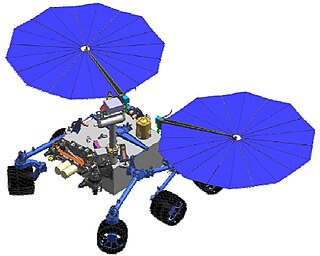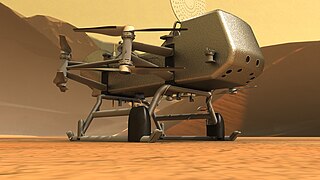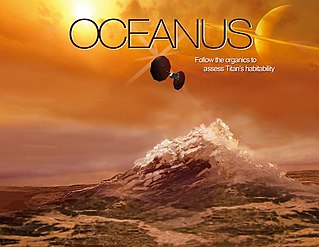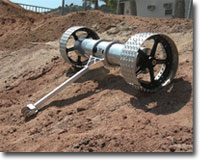
The Discovery Program is a series of Solar System exploration missions funded by the US National Aeronautics and Space Administration (NASA) through its Planetary Missions Program Office. The cost of each mission is capped at a lower level than missions from NASA's New Frontiers or Flagship Programs. As a result, Discovery missions tend to be more focused on a specific scientific goal rather than serving a general purpose.

Observations of the planet Venus include those in antiquity, telescopic observations, and from visiting spacecraft. Spacecraft have performed various flybys, orbits, and landings on Venus, including balloon probes that floated in the atmosphere of Venus. Study of the planet is aided by its relatively close proximity to the Earth, compared to other planets, but the surface of Venus is obscured by an atmosphere opaque to visible light.
The New Frontiers program is a series of space exploration missions being conducted by NASA with the purpose of furthering the understanding of the Solar System. The program selects medium-class missions which can provide high science returns.

Venera-D is a proposed Russian space mission to Venus that would include an orbiter and a lander to be launched in 2029. The orbiter's prime objective is to perform observations with the use of a radar. The lander, based on the Venera design, would be capable of operating for a long duration on the planet's surface. The "D" in Venera-D stands for "dolgozhivushaya," which means "long lasting" in Russian.

The Venus In Situ Explorer (VISE) has been a lander mission concept proposed since 2003 by the Planetary Science Decadal Survey as a space probe designed to answer fundamental scientific questions by landing and performing experiments on Venus.

The Mars Astrobiology Explorer-Cacher (MAX-C), also known as Mars 2018 mission was a NASA concept for a Mars rover mission, proposed to be launched in 2018 together with the European ExoMars rover. The MAX-C rover concept was cancelled in April 2011 due to budget cuts.

Phobos And Deimos & Mars Environment (PADME) is a low-cost NASA Mars orbiter mission concept that would address longstanding unknowns about Mars' two moons Phobos and Deimos and their environment.

Lunar Flashlight is a planned low-cost CubeSat lunar orbiter mission to explore, locate, and estimate size and composition of water ice deposits on the Moon for future exploitation by robots or humans.
OKEANOS was a proposed mission concept to Trojan asteroids, which share Jupiter's orbit, using a hybrid solar sail for propulsion; the sail was planned to be covered with thin solar panels to power an ion engine. In situ analysis of the collected samples would have been performed by either direct contact or using a lander carrying a high-resolution mass spectrometer. A sample-return to Earth was an option under study.

DAVINCI is a planned mission for an orbiter and atmospheric probe to the planet Venus. Together with the VERITAS mission, which will also study Venus, it was selected by NASA on 2 June 2021 to be part of their Discovery Program.

Dragonfly is a planned spacecraft and NASA mission, which will send a robotic rotorcraft to the surface of Titan, the largest moon of Saturn. It would be the first aircraft on Titan and is intended to make the first powered and fully controlled atmospheric flight on any moon, with the intention of studying prebiotic chemistry and extraterrestrial habitability. It will then use its vertical takeoffs and landings (VTOL) capability to move between exploration sites.

Oceanus is a NASA/JPL orbiter mission concept proposed in 2017 for the New Frontiers mission #4, but it was not selected for development. If selected at some future opportunity, Oceanus would travel to Saturn's moon Titan to assess its habitability. Studying Titan would help understand the early Earth and exoplanets which orbit other stars. The mission is named after Oceanus, the Greek god of oceans.

SPRITE was a proposed Saturn atmospheric probe mission concept of the NASA. SPRITE is a design for an atmospheric entry probe that would travel to Saturn from Earth on its own cruise stage, then enter the atmosphere of Saturn, and descend taking measurements in situ.
Venus In Situ Atmospheric and Geochemical Explorer (VISAGE) is a proposed Venus lander mission that would perform atmospheric and surface science investigations.
Venus Origins Explorer (VOX) is a concept orbiter mission to Venus.
Venus Atmospheric Maneuverable Platform (VAMP) is a mission concept by the aerospace companies Northrop Grumman and LGarde for a powered, long endurance, semi-buoyant inflatable aircraft that would explore the upper atmosphere of planet Venus for biosignatures as well as perform atmospheric measurements. The inflatable aircraft has a trapezoidal shape that is sometimes called delta wing or flying wing, and would have dual electric-driven propellers that would be stowed during atmospheric entry.
CubeSat UV Experiment (CUVE) is a space mission concept to study the atmospheric processes of the planet Venus with a small satellite. Specifically, the orbiter mission would study an enigmatic ultraviolet light absorber of unknown composition situated within the planet's uppermost cloud layer that absorbs about half the solar radiation downwelling in the planet's atmosphere.

Moon Diver is a proposed lunar mission concept by NASA's Jet Propulsion Laboratory that would employ a robotic lander and a two-wheeled rover called Axel to investigate the exposed geological layers on the walls of a deep lunar pit.
MANTIS is a mission concept that would flyby 14 asteroids covering a wide range of types and masses, and obtaining remote sensing and in-situ data. This mission would explore the diversity of asteroids to understand the Solar system's history, its present processes, and hazards. The concept was proposed in 2019 to NASA's Discovery Program to compete for funding and development.


















